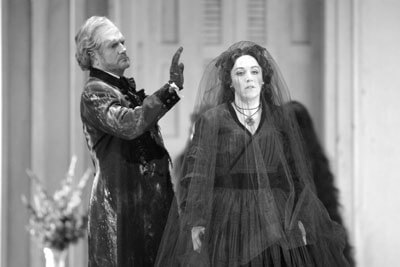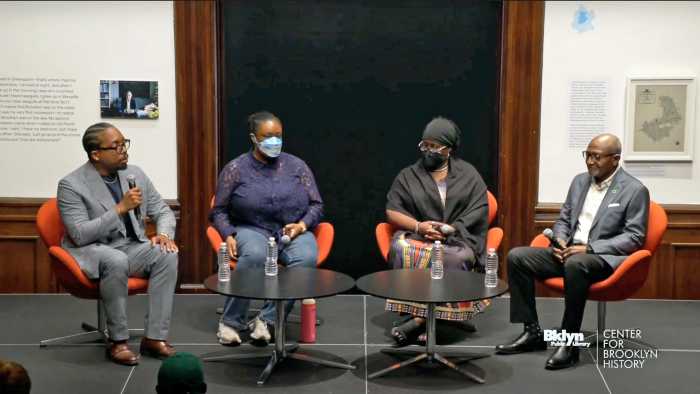Mediocre “Mourning” features divas’ intense roles in the most dysfunctional of families
When I was just a budding opera princess, cutting classes so I could hang around the university library and read old copies of Opera News, I always wondered about Marvin David Levy’s “Mourning Becomes Electra” — in particular why the piece was never revived after its Metropolitan Opera premiere in 1967.
Certainly the opera looked interesting enough. I can recall in particular a full-page photo of Evelyn Lear and Marie Collier as Lavinia and Christine Mannon, arrestingly scary in their helmet-bouffant wigs, bullet-bra bodices, and about a quart of liquid eyeliner each. But what in the world was the music like?
Well, on March 27 I found out, during the New York City Opera’s revival of the opera, and I’m afraid Levy’s composition dates as badly as the maquillage of Mmes. Lear and Collier.
In a way, “Mourning Becomes Electra” was City Opera material from the beginning, a conservatively dissonant, mildly erotic middlebrow piece that could fit right into a repertoire featuring Beeson’s “Lizzie Borden” and all those Thomas Pasatieri adaptations. The libretto, by Henry Butler, efficiently condenses seven hours of Eugene O’Neill’s Freudian bellyaching into three longish acts, setting up plausible opportunities for arias, duets and even a reflective quartet.
Here and there Levy’s music sounds strikingly like Richard Strauss — not “Elektra,” as you might expect, but rather “Die Frau ohne Schatten.” But I don’t see that the composition enhances the play any more than soundtrack music; brass stings punctuate moments of shock, low string tremolos crank up the tension in waiting scenes, and eerie woodwind tone clusters indicate incipient madness. There’s nothing here that would be out of place accompanying a Hitchcock thriller.
On the other hand, Levy’s vocal writing for his two leading ladies is exciting and showy, alternating percussive lines in chest register, daring leaps to high B-flats and C’s, and the occasional parlando cry to rouse the gallery. Combine these delights with the contrasting characters (sensuous Christine and repressed Lavinia), and you get a very effective vehicle for a pair of vibrant singing actresses. At NYCO the dueling sopranos (Lauren Flanigan and Emily Pulley) provided as much diva electricity as Off Broadway’s “Johnny Guitar.”
In the O’Neill original, Lavinia (the Electra character) is clearly the lead; in fact, Christine (Clytemnestra) is dead by the end of the second play of the trilogy. In the current revision, Christine’s role is by far the more grateful, suiting Ms. Flanigan’s boldly emotional acting and hell-for-leather vocalism down to the last lurch and scream. Her steely soprano is in superb form, coolly veiled in middle voice and tirelessly swordlike on top. Flanigan built Christine’s third act scene of contrition and suicide into the emotional high point of the opera.
Matching Ms. Flanigan’s intensity, Emily Pulley came in a close second only because Mr. Levy gives her somewhat less flashy material. For two acts she scowls and schemes, but even when she perks up after her mother’s suicide, Lavinia is still a stick. Ms. Pulley has the gift of quiet intensity onstage, though, and she sings the heavy vocal lines tirelessly, still sounding fresh in the long final scene. A particular surprise in this lyric soprano’s voice is her easy access to a vehement chest tone, which suggests more verismo assignments in her future.
The men of “Mourning” are mostly for the ladies to fight over, so the male roles are pretty thankless. Jason Howard (Adam Brant) boasted a smooth lyric baritone with intense top notes, but Kurt Ollman (Orin) crooned and belted like a Broadway singer. Conductor George Manahan kept the busy score under control, finding time to throw accurate cues to his singers for the literally hundreds of tricky entrances in the score.
Director Bartlett Sher had a couple of odd notions about post-bellum New England social behavior. (Would the widow Christine really invite a neighbor to sing a love ditty at her late husband’s wake and in the same room as the laid out corpse?) Other than that, the performers moved fluidly around Michael Yeargan’s handsome Greek revival drawing room, vastly superior to the ugly sets he designed for the Met’s new “Don Giovanni” last month.
James Jorden is the editor of parterre box, the queer opera zine (parterre.com)
We also publish:


































